The 19th-century theatre had a double function – it offered an ambitious repertoire, and was an element of ‘high culture’, but it was also a way to spend an evening, not necessarily ambitiously – says Agata Łuksza (Institute of Polish Culture, University of Warsaw) in an interview for polishhistory.pl
Nowadays, when we say ‘theatre’ we usually think of a special institution with a stable staff and its own building, which deals with high culture. To what extent does such a description correspond to what Polish theatre looked like in the 19th century?
It is a certain construct that has settled well in our heads – different theatres, also nowadays, look differently. They do not always function as an institution, they are not always classified as high culture. But you are right – this is a certain image that emerged at the end of the 19th century. In the course of the 19th century, some aspects of this notion function, but it is not a coherent model. The basic difference is that, for the 19th-century audience, theatre was the primary entertainment as there were no other media. It was a place that had a double function – it offered an ambitious repertoire and was an element of ‘high culture’, but it was also a way to spend an evening, not necessarily in a high-brow kind of way. One would not always see the plays in their entirety – the audience came to see selected acts or selected scenes. So this division into high and low culture was not fully established here.
And what did the institutional base of Warsaw theatres look like in the 19th century?
The institution of Warsaw Theatres existed, controlled and subsidised by the tsarist authorities – and it was an institution in the full sense of the word, with its own building, administration, staff, permanent ensemble, or repertoire. There were also garden theatres, which had a slightly different form – they were organised on an ad hoc basis. In the summer, restaurateurs would rent out their gardens, which had been adapted to the needs of spectacles, to theatre groups that came to Warsaw from the provinces. Provincial theatres usually closed down at that time, and theatre companies came to Warsaw to earn money – there was an opportunity for this, because the repertoire of Warsaw Theatres was limited during summer holidays. Who would come and what they would play was a surprise each year.
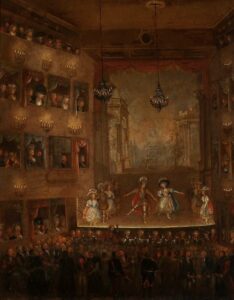
The oldest still functioning theatre in Poland is the National Theatre in Warsaw. Among the many theatres in contemporary Warsaw, it is held in particular esteem. In what circumstances was it founded?
The patron and initiator of the entire project was Stanisław August Poniatowski, the last king of the Polish-Lithuanian Commonwealth. The establishment of this theatre in 1765 was the result of Enlightenment trends influencing intellectual life in Poland. We recently celebrated the 250th anniversary of its founding.
The novelty was the creation of a public theatre: henceforth anyone who paid for a ticket could see the show. This had never happened before. If performances were given at magnates’ courts, it was elite-reserved entertainment. Of course, there were also street theatres – but these were ad hoc initiatives.
How did the National Theatre function during the partition period, when the Polish monarch-patron, whose role you mentioned, was missing? How did the theatre cope with the pressure of Russian rule?
At the end of the 18th century, when the National Theatre was founded, the King was the patron, undoubtedly. Also enthusiasts of the ‘public enlightenment’ of the time used the theatre as a propaganda tube. Yet the theatre of the early 19th century is a place where the audience has the decisive voice. And this is a relationship that is transformed in the course of the 19th century until the formation of the modern formula, when we sit quietly and follow the etiquette. 19h-century audiences were able to control the repertoire and the choice of casts with their opinions.
However, as far as those in power are concerned, they came to an agreement. Theatres became an institution subordinate directly to the tsarist authorities. There was a chairman of Warsaw Theatres, who was generally Russian, and generally from the military. The artists got along easier with some, worse with others.
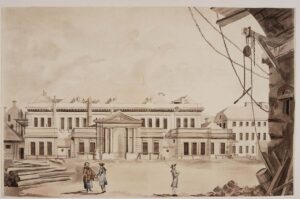
Censorship was one of the elements of government influence on theatre. Did it pose many problems?
It was a challenge. They managed it in different ways. Artists developed different methods of communicating with the audience, which the censors did not fully understand, or understood too late. It seemed that the text was all right and the actors presented it in such a way – e.g. by adding a gesture or meaningful silence (especially where the censor had crossed something out) – that the entire statement acquired patriotic, even rebellious tones. This is also important – censors did not only cut patriotic themes. Certain censorship rules existed for the entire Russian Empire, and one of them was to remove all allusions to power. The image of the Tsar, for example, was very strongly protected.
The attitude of the Russian invaders to the theatre was ambivalent, and to this day it is not entirely clear what they had in mind. How was it possible, given the scale of the suppression of Polish culture, especially after the fall of the January Uprising, to have a large theatre in the middle of the city where Polish was spoken and even celebrated? The golden period of the Warsaw Theatres was the management of Sergei Mukhanov (1868 –1880), because he, although an officer of the Tsar, was a polonophile, and loved Polish theatre, as did his wife, Maria Kalergis. Both were even patrons of the theatre.
Censorship also resulted in a kind of theatre tourism. At the end of summer holidays – at the beginning of the theatre season – many citizens of the Kingdom of Poland, returning home from foreign holidays, would arrange their itinerary in such a way as to pass through Krakow, and attend the theatre there. In Galicia, it was not a problem to stage Kościuszko at Racławice or other patriotic plays.
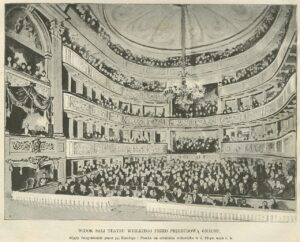
What was the everyday work of a theatre actor in the 19th century like?
It was very difficult. We often think that this is a pleasant, well-paid profession. Yes – but only for the producer. It is such a Hollywood myth that anyone can become a star. In the 19th century, it was a thankless profession. If you found yourself in the Warsaw Theatres, you touched the edge of heaven indeed, because it was a fixed contract, a fixed salary. It also depended on whether you were a leading actor or someone who appeared on the stage for a while. The stars had it pretty good – but there were not many of them either, there were only a few names who could be said to have earned well. However, the life of a provincial actor was a great challenge. It was often a life in poverty, in hunger, with an uncertain future, on the road – remember what travelling looked like in the 19th century! We performed in makeshift buildings. We do not remember today that actors used to be mostly itinerant. They were troupes that circulated, and you can see this, for example, in those that played in Warsaw gardens. When they had a good season, they were able to earn money for half a year. And if they had a worse season, they came back empty-handed and had a tough year. But some could not imagine a different life. It was a profession that allowed them to live a little differently – to break away from the norm. Actors were admired on the one hand but, on the other, they were somewhat treated as social outcasts.
Can we talk about the phenomenon of celebrities in the 19th century? Were there any actors who were particularly popular and appreciated by the audience? Were they interested not only in their profession, but also in their private life?
Yes, naturally. Warsaw was very famous for its ‘celebrity culture’, which began to emerge in the 19th century. It was, of course, connected with the dynamic development of the city after the January Uprising. Helena Modrzejewska, for example, gained great popularity – she started off as an itinerant actress, later on contracts in Krakow and Warsaw, and then in the United States. The press closely followed the personal adventures of the public’s favourite. Popular actors became role models, both in terms of their life choices and their appearance. Actresses, in particular, became such models – a special role was played here by the increasing mass distribution of photos. You could even buy packets of cigarettes with miniature photographs of your favourites attached. It was already then that people began advertising products by associating them with celebrities.
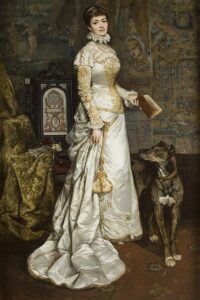
You mentioned Modrzejewska – could you tell us about the beginnings of her career?
Modrzejewska’s career began in the provinces, where she performed in the ensemble of Gustaw Zimajer, her first life companion. She later joined a theatre in Krakow, and it was here that her spectacular success began. Quite conservative and reserved, Krakow was divided into lovers of Antonina Hoffman, a major star of the local theatre at the time, and of the young Modrzejewska. Apparently, this almost divided families. During this period, Modrzejewska also travelled to Warsaw for guest appearances – which was typical of 19th-century theatre, when actors from big cities visited the provinces and vice versa. Often, those who came to big cities hoped that, after successful performances, they would get a contract with Warsaw Theatres.
This is what happened in the case of Modrzejewska – she had very successful performances in Warsaw. At that time, the president of the Warsaw Theatres was the aforementioned Mukhanov, who shared with Modrzejewska a certain vision of how to improve Warsaw theatre, and how to change the repertoire. Shakespeare was forced through despite censorship, while being banned in the whole of Russia. How was Hamlet pushed through? The argument was that it was not a drama about power, just one about family problems. Thus, Hamlet appeared on the Warsaw stage after a gap of many years. Modrzejewska’s popularity grew, although it must have been difficult for her, as Warsaw also had its own structures – artists formed groups in which everyone had their own position. And then, suddenly, there came the Cracovienne, who occupies this leading position – she had an incomparably better contract than the rest of the company, so she had to put up with personal animosities. But the audience loved her, so she performed in Warsaw for several years with great success, and this is a period that is celebrated in the history of Polish theatre, perhaps overly so. The 19th century is often reduced to Modrzejewska performing in Warsaw.
Later on, Modrzejewska embarked on an international career. What prompted her to leave?
Modrzejewska also participated in the intellectual life of the city. She ran her own salon, and had a circle of admirers. Gierymski, Witkiewicz, Sienkiewicz, and many others frequented her salon. Of course, they had crushes on her, but it was also the beginning of some intellectual ferment. One of the ideas they came up with at the time was to travel together to California and set up an artistic commune with Sienkiewicz and others. Modrzejewska went there in 1876 with her husband, Karol Chłapowski. The group functioned for about a year, then broke up because digging potatoes with her own hands turned out to be incompatible with the utopian projects. In the meantime, however, Modrzejewska was preparing to perform in the United States. Apart from her ideals, she simply wanted to make a career overseas. She dreamed of playing Shakespeare in the original version. American audiences were said to be less demanding than, say, British ones, so the American audience was supposed to be a good place to start her international career, which Modrzejewska did successfully.
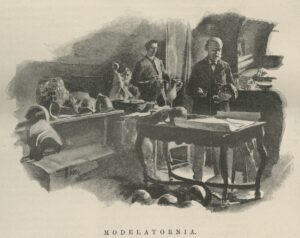
You also mentioned another famous actress who performed at the Warsaw theatre, Sara Bernhardt. How did she stand out among other theatre artists of the time? How was her acting accepted by the audience?
Sara Bernhardt embodied the neurosis of the end of the century. She built her image on this assumption. She was thus completely different from Modrzejewska, who created herself as a distinguished lady. It was even said that aristocratic women should learn how to behave, carry themselves, and express themselves from her. Bernhardt, on the other hand, based her image on eccentricity. She chose her roles and built her image in the eyes of the audience in such a way so as to emphasise her peculiarity. She crossed boundaries programmatically. She also had a different type of beauty – very slim by the standards of the fashion of the time, and she emphasised it. What is also important, she was of Jewish origin, which was significant in the culture of the late 19th century.
She visited Warsaw three times – the first time in January 1882. It was predicted to be a total disaster, but in the end the public went crazy about her. The critics were delighted. The only thing that was somehow disturbing was that young girls were also enthralled and started to imitate Sarah Bernhard, which the satirical press soon began to make fun of. Not only her appearance, but also her private life was outside of the norm, which was all the more disturbing. She liked to play the parts of fallen women, appear in melodramas, and was even famous for her expressive scenes of dying.
We have spoken about actresses, but what can we say about the audience of the time?
The audience of the government’s Warsaw Theatres was different from the one of the garden theatres. Warsaw Theatres also had different stages, and different people visited them – be it the Grand Theatre, the Variety Theatre, or any other. So it is quite difficult to characterise that audience as a whole.
The audience of Warsaw Theatres was stratified – although within certain social spheres – because this institution was somewhat snobbish and elitist, especially at the end of the 19th century. Warsaw residents from the emerging working class did not go there. It was mainly the aristocracy, intelligentsia, and landed gentry visiting the capital, officers, bourgeoisie, and students. The more affluent attended premieres to show off. Different audiences enjoyed different works. For example, ballet was considered undemanding entertainment for the uneducated – because they do not say anything, just dance. On the other hand, ballet was loved by the Russian officers.
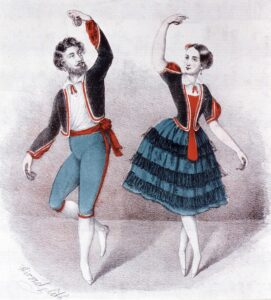
And what was the situation like at the garden theatres?
The garden theatres were more egalitarian. Everybody went there, nobody was ashamed to go, because there was a different repertoire, different money. So those theatres were fully accessible for the lower classes, also financially. And the upper classes went there out of curiosity, for a change. As time went by, some of the gardens began specialising in certain genres, and it was known that, for example, the ‘golden youth’ sat here, Jews sat there, etc.
What were the most popular plays in Warsaw in the 19th century?
It is difficult to point to one specific title. Theatre critics had their patriotic aspirations, and Warsaw Theatres attempted to present mainly a serious repertoire, but French comedies dominated the stage anyway – and they did so throughout the entire 19th century. There was also a good deal of German melodrama, for example by August Kotzebue, as well as classical tragedies and some Shakespeare. And this proportion remained the same throughout most of the 19th century.
The most popular author whose works were exhibited was Eugene Scribe, who wrote comedies, melodramas, one-act plays, opera, and operetta librettos. The most popular among the Polish authors were Aleksander Fredro (both father and son) and Michał Bałucki. However, French domination was overwhelming and lasted throughout the 19th century. It was only in the last decade that the theatre began to open up to new currents – to modernism, to decadent plays – but slowly. More novelties appeared on garden stages, they caught new trends earlier, because Warsaw Theatres were still quite a rigid institution.
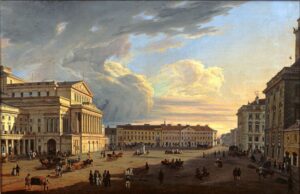
How did the functioning of Polish theatre in the 19th century influence the canon of Polish culture? What events or theatrical figures are important also from today’s perspective?
The very building of the Grand Theatre in Warsaw is a certain symbol. It burnt down many times, it had its ups and downs, moments when it ceased to be the centre around which theatrical life revolved, but it is undoubtedly a permanent fixture on the map of Warsaw – both the geographical and the mental. In the 19th century, Theatre Square was also the centre of social life. The best cafés and shops, as well as press offices, were located there. The theatre itself was a whole conglomerate of entertainment, not just theatre. It seems significant to me that the National Theatre today is located where the Variety Theatre used to be, taking responsibility for cultivating the Polish language. Also the artists associated with this theatre who, despite the difficult working conditions, have left their mark on the world. Modrzejewska – but not only she – is such an example. The theatre was also a hub of cultural exchange – between parts of partitioned Poland, but also between other countries.




